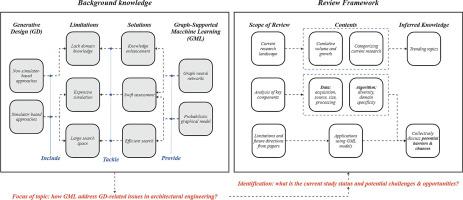推进建筑工程生成设计中图形支持的机器学习
IF 11.5
1区 工程技术
Q1 CONSTRUCTION & BUILDING TECHNOLOGY
引用次数: 0
摘要
图支持机器学习(GML),包括图神经网络(gnn)和概率图形模型(PGMs),显示了解决建筑工程中生成设计(GD)挑战的希望。然而,对其使用、局限性和未来潜力的系统回顾仍然缺乏。本文通过分析70篇同行评议的论文,映射它们的应用、数据源和模型类型来解决这一差距。两层分析确定了关键的局限性,包括数据集小、泛化范围窄、物理定律或专家反馈的有限整合。为了克服这些挑战,提出了五个战略方向:共同进化的数据和算法、贝叶斯网络和gnn混合建模、图稀疏化、人在环设计细化和物理信息学习。这些方向指导了更通用和实用的GML模型的开发,能够跨规模适应,降低计算成本,并与设计意图和工程原则保持一致。研究结果旨在通过加强计算机辅助设计,促进创新设计实践和推进建筑自动化。本文章由计算机程序翻译,如有差异,请以英文原文为准。

Advancing graph-supported machine learning in generative design for architectural engineering
Graph-Supported Machine Learning (GML), including Graph Neural Networks (GNNs) and Probabilistic Graphical Models (PGMs), shows promise for tackling Generative Design (GD) challenges in architectural engineering. However, a systematic review of its use, limitations, and future potential is still lacking. This paper addresses that gap by analyzing 70 peer-reviewed papers, mapping their applications, data sources, and model types. A two-tier analysis identifies key limitations, including small datasets, narrow generalization, and limited integration of physical laws or expert feedback. To overcome these challenges, five strategic directions are proposed: co-evolving data and algorithms, hybrid modeling with Bayesian Networks and GNNs, graph sparsification, human-in-the-loop design refinement, and physics-informed learning. These directions guide the development of more versatile and practical GML models, able to adapt across scales, reduce computational cost, and align with design intent and engineering principles. The findings are intended to foster innovative design practices and advance automation in construction through enhanced computer-aided design.
求助全文
通过发布文献求助,成功后即可免费获取论文全文。
去求助
来源期刊

Automation in Construction
工程技术-工程:土木
CiteScore
19.20
自引率
16.50%
发文量
563
审稿时长
8.5 months
期刊介绍:
Automation in Construction is an international journal that focuses on publishing original research papers related to the use of Information Technologies in various aspects of the construction industry. The journal covers topics such as design, engineering, construction technologies, and the maintenance and management of constructed facilities.
The scope of Automation in Construction is extensive and covers all stages of the construction life cycle. This includes initial planning and design, construction of the facility, operation and maintenance, as well as the eventual dismantling and recycling of buildings and engineering structures.
 求助内容:
求助内容: 应助结果提醒方式:
应助结果提醒方式:


